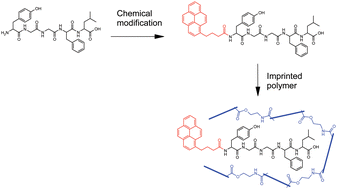Peptide-imprinted polymer microspheres prepared by precipitation polymerization using a single bi-functional monomer†
Abstract
A single bi-functional monomer,

* Corresponding authors
a
Pure and Applied Biochemistry, Chemical Center, Lund University, Box 124, S-221 00 Lund, Sweden
E-mail:
Lei.Ye@tbiokem.lth.se
Fax: +46 46 2224611
Tel: +46 46 2229560
b Department of Chemistry, Louisiana State University, Baton Rouge, Louisiana 70803, USA
A single bi-functional monomer,

 Please wait while we load your content...
Something went wrong. Try again?
Please wait while we load your content...
Something went wrong. Try again?
K. Yoshimatsu, J. LeJeune, D. A. Spivak and L. Ye, Analyst, 2009, 134, 719 DOI: 10.1039/B814967D
To request permission to reproduce material from this article, please go to the Copyright Clearance Center request page.
If you are an author contributing to an RSC publication, you do not need to request permission provided correct acknowledgement is given.
If you are the author of this article, you do not need to request permission to reproduce figures and diagrams provided correct acknowledgement is given. If you want to reproduce the whole article in a third-party publication (excluding your thesis/dissertation for which permission is not required) please go to the Copyright Clearance Center request page.
Read more about how to correctly acknowledge RSC content.
 Fetching data from CrossRef.
Fetching data from CrossRef.
This may take some time to load.
Loading related content
